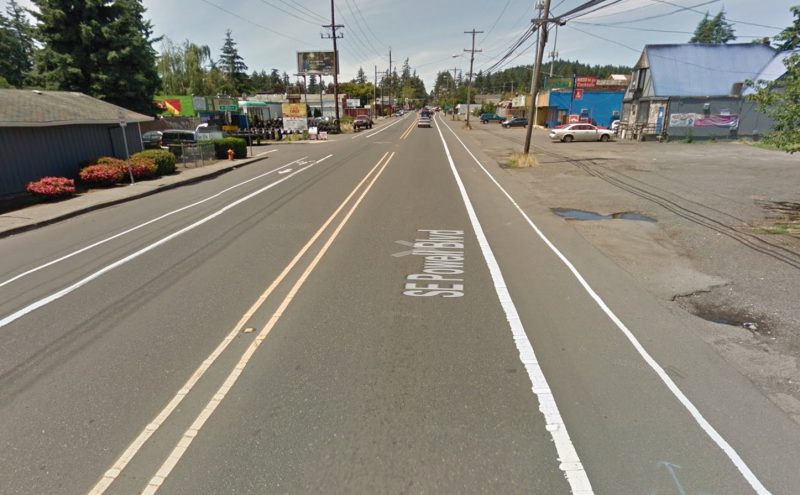
18 months of debate about how to provide safe bike access on a 14-block stretch of Southeast Powell Boulevard is finally coming to an end. At least the Oregon Department of Transportation hopes it is.
Saying they are now months behind schedule, ODOT wants to move forward into the final design stage of a project that will rebuild Powell between SE 122nd and 136th. With $17 million from the State Legislature and another $3 million from Metro, the latest incarnation of ODOT’s Outer Powell Safety Project will add a host of updates to this state highway (U.S. Route 26), which has one of the worst crash records of any road in Oregon. This project will bring long-awaited changes and additions to signals, sidewalks, intersections, landscaping, crosswalks, and bike lanes.
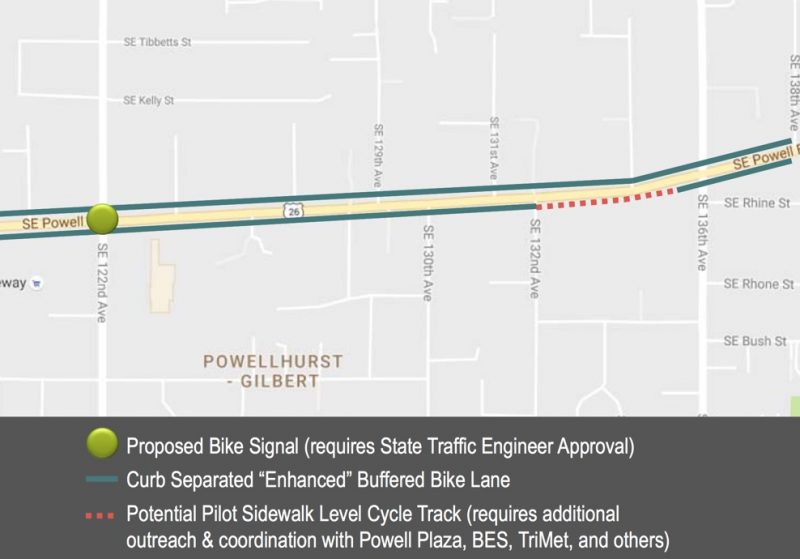
It’s those bike lanes that have been the sticking point: ODOT, project advisory committee members, east Portland neighborhood advocates, and the City of Portland all have different ideas about what type of bike facility should be implemented. Where ODOT sees a state highway with 20,000 cars per day passing though, the Portland Bureau of Transportation (PBOT) sees a once-in-a-lifetime opportunity to create a high-quality biking and walking environment that will help east Portland grow in a much safer, healthier and more efficient way. And residents who live in this area just want a street they can use and cross without fear of being killed.
For months now, the East Portland Action Plan (EPAP, a City of Portland funded neighborhood group) has been a thorn in ODOT’s side in an effort to push the agency further on the bicycle facility. I rolled out to their meeting at David Douglas High School last week to learn the latest.
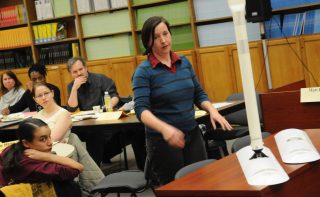
(Photo: J. Maus/BikePortland)
At the EPAP meeting on Wednesday, ODOT announced they plan to implement their first-ever physically protected bike lane on a state highway. ODOT also says they’ll consider a “potential” raised cycle track for a short segment of the street — something that will require formal design exceptions to be granted by the state traffic engineer and something EPAP’s representative on the project doesn’t even trust ODOT to actually follow through on.
ODOT’s Region 1 Transit and Active Transportation Liaison Jessica Horning was at the meeting to clarify the agency’s intentions. She brought with her two sets of white, plastic “Tuff-Curbs” with vertical delineator posts attached to them. Horning said ODOT’s plan is to use this product to create physical separation in the two-foot buffer zone that will separate the six-foot bike lane from motor vehicle traffic. “This is going to be our first physically separated bike lane on an ODOT facility in the state,” she told me after the meeting.
This section of Powell currently has one standard lane and one bike-only lane in each direction — and lacks complete sidewalks. A major safety concern is how people drive into the bike lane in order to swerve around other drivers who stop to make turns. The center turn lane and plastic posts and curbs separating the bike lane will hopefully end that behavior. Take a look at the proposed cross-section below and keep in mind it doesn’t show the plastic curbs or the concrete that will be used for the bike lane in order to make it stand out visually:
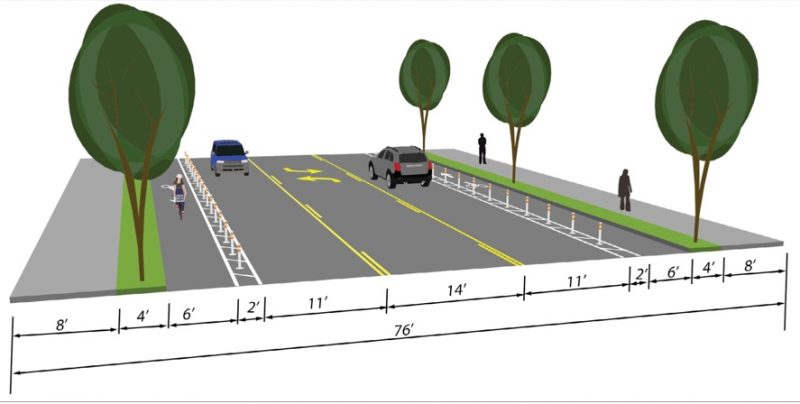
And here’s the new traffic signal ODOT will install at the intersection with 122nd to prevent right-hooks:
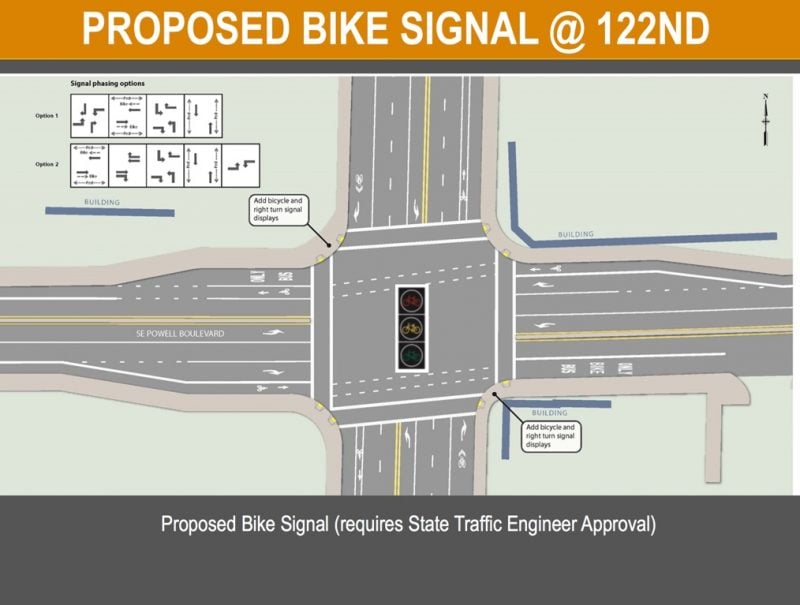
There’s no guarantee it will happen, but here’s what ODOT is considering as a pilot project between 132nd and 136th:
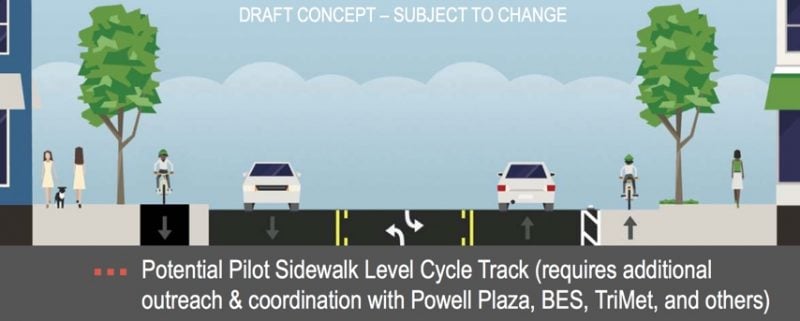
Horning feels this is a big step for ODOT. “When you think about our standard treatment for a highway like Powell, if you just look at the [design guideline] books, it’s a six-foot bike lane and six-foot curb-tight sidewalk and we’re going to have an eight-foot buffered bike lane with physical separation that’s a different material than the pavement itself, a landscape strip with stormwater treatment, and a sidewalk. I’m excited about that.”
Some advocates and the City of Portland don’t share her enthusiasm. While eager for any safety improvements to Powell after fighting decades for changes, they want ODOT to get it right the first time.
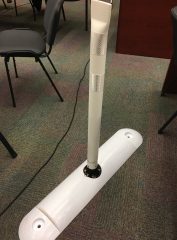
Jim Chasse, who lives near 116th and Powell and rides on the street almost daily, has advocated for safety on the street for nearly 20 years (we profiled him in 2014). “The neighborhood’s position is, we just want it fixed,” he told me in a phone interview last night. “Fixed to the best standards we can get. We told ODOT, we’re willing to work with you, but you need to be willing to work with us.”
Chasse is also concerned about how hundreds of white plastic posts and curbs will look. “We want something that’s aesthetically pleasing. It’s our neighborhood. To have these reflective wands going down the street… It may be safer, but how would you feel about looking at those things day-in and day-out? I’m OK with them but I’m not a big proponent.”
From ODOT’s perspective, they have worked with EPAP. The vertical posts and potential cycle track plans go further than the agency initially wanted to go. When the project began in July 2015 only buffered bike lanes — with no physical separation — were on the table. But that didn’t sit well with advocates or with the City of Portland. Advocates wanted raised bike lanes/cycle tracks that would be at sidewalk level (similar to ones on SW Multnomah and NE Cully) and they were optimistic that ODOT was at least receptive to the idea. A year later however, ODOT nixed the raised lane idea. After analyzing the design, state traffic engineers felt it would be too challenging. They cited potential issues with stormwater drainage, freight truck movement, the over 300 driveways in the corridor that would interfere with it, and the difficulty of sweeping the relatively narrow lanes. And on the north side of the street, ODOT said any type of raised bike lanes would be out of the question because of a 52-inch, 100-year old water pipe that sits just three feet below the surface.
“Each [one of these issues] on their own wasn’t a dealbreaker,” ODOT’s regional engineer on the project told us in July 2016, “but taken in aggregate [a raised bike lane] presents a long list of challenges.”
While ODOT was able to convince their official project advisory committee that buffered bike lanes would suffice, advocates with EPAP were not satisfied. EPAP vowed to continue fighting for more significant physical separation between bicycle and car users — especially on the south side of the street where there’s no issue with an old water pipe. EPAP wanted to know: If ODOT is willing to consider a cycle-track on four blocks on the south side of the street, why not do it on the entire stretch?
Because of EPAP’s persistent advocacy, ODOT decided to pause the project and work with them and the City of Portland to try and find a bikeway treatment that would satisfy everyone. By last fall, ODOT made some progress, but not everyone was on the same page.
Advertisement
At their October Bicycle Advisory Committee (BAC) meeting, PBOT made a rare move to influence the project: After ODOT shared their plans, PBOT stepped up and shared theirs. Keep in mind, this is ODOT’s road and ODOT’s project; it was an extraordinary step for PBOT to present a dueling design at this late stage of the project. It was clear that PBOT was frustrated. They felt ODOT was not trying hard enough to create a bike facility that would attract “interested but concerned” riders.
Powell might be ODOT’s road, but the goal of 25 percent bicycle mode share by 2030 — officially adopted by City Council in the Climate Action Plan — is squarely on PBOT’s shoulders.
Instead of the six-foot bike lane and two-foot buffer in ODOT’s plans, PBOT traffic engineer Lewis Wardrip presented a plan for seven-foot wide raised cycle-tracks on both sides of Powell that would be separated from motorized traffic by a four-foot planting strip. Here’s PBOT’s cross-section:
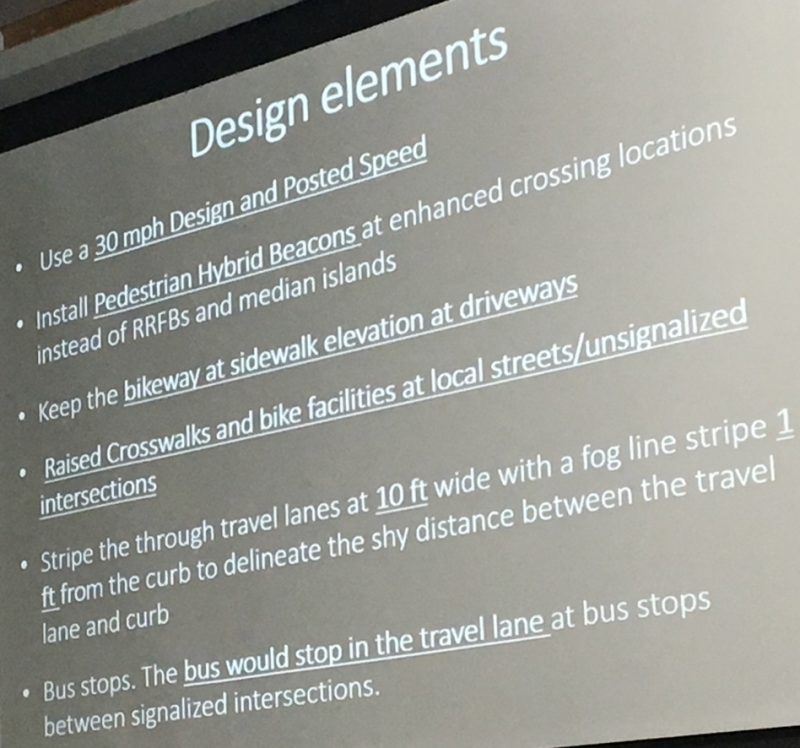
Wardrip also presented a list of “design elements” they’d like to see on the project. They included: a speed limit of 30 mph (instead of 35); the use of button-activated hybrid traffic signals (aka “HAWK” signals) instead of flashing beacons; keep the bikeway at sidewalk elevation at all driveways (ODOT assumes a raised lane would have to dip down, then go back up at each driveway); and maintain raised crosswalks and bikeway at local streets.
“How people move through a space is more important than how water moves through a space. We’re here to tell you to push the envelope further.”
— Ian Stude, chair of the City of Portland Bicycle Advisory Committee
In response, ODOT said the type of bike facility PBOT wants is simply not possible right now. At that October BAC meeting, ODOT project manager Mike Mason said the water pipe under the north side of the street is too big of a challenge to deal with. Upon hearing those concerns, BAC Chair Ian Stude said, “How people move through a space is more important than how water moves through a space. We’re here to tell you to push the envelope further.”
That was October. Between then and now, ODOT has decided to keep their plans essentially the same. In addition to what they feel are myriad technical challenges with a more robust bike facility, they are feeling pressure to finalize the decision. In June 2016, four months prior to the BAC meeting with PBOT, ODOT Interim Area Manager Shelli Romero (according to meeting minutes) told the project’s advisory committee that, “This is a critical time for the project to move forward and not be delayed… If it doesn’t continue to move forward now it can threaten the project and timeline.”
Now six months later, EPAP is still uneasy with ODOT’s plans.
“We’ve now spent two years reviewing and reconsidering the bike improvement options for Outer Powell… ODOT has given the design team the go ahead to move quickly.”
— Rian Windsheimer, director of ODOT Region 1
In November, EPAP sent a letter (PDF) with a list of demands to ODOT Region 1 Manager Rian Windsheimer, (former) PBOT Commissioner Steve Novick, and PBOT Director Leah Treat. The letter was signed by five Oregon State Representatives, former Bicycle Transportation Alliance (now The Street Trust) Executive Director Rob Sadowsky, and six representatives of the East Portland Action Plan.
In that letter EPAP said they understand the limitations presented by the water pipe on the north side of the street and they’d be willing to support the buffered bike lane with vertical delineation. Beyond that, they demanded the same things PBOT presented at the BAC meeting a month prior: a cycle-track treatment for the entire length of the project on the south side of the street; hybrid “HAWK” traffic signals instead of flashing beacons; a speed limit reduction to 30 mph; and a bike-only signal at Powell and 136th to prevent right-hook collisions.
“After careful review of the proposed update to the Transportation System Plan and the Bicycle Plan for 2030, as well as discussions with PBOT staff, we feel that the current proposed buffered or tuff curb design does not meet the City’s goal to design facilities that will attract all ages and abilities, nor does it utilize best practice design that is suitable for main arterials in Portland.”
— from a joint letter to ODOT Region 1 Director signed by the Portland Bicycle Advisory Committee and Pedestrian Advisory Committee
It took ODOT nine weeks to reply (a fact that has frustrated EPAP, given the timeline concerns expressed by ODOT staff). In his January 18th letter in response (PDF), Windsheimer thanked EPAP for their advocacy and support, but made clear his intention to move on. “We’ve now spent two years reviewing and reconsidering the bike improvement options for Outer Powell… Now, having reached a decision for moving ahead on the bike treatment, which was the only outstanding element from the decision committee’s recommendation back in 2015, ODOT has given the design team the go-ahead to move quickly…”
Windsheimer also addressed each of EPAP’s outstanding demands.
He said ODOT won’t consider the pilot cycle-track beyond the four-block segment. “Due to the large number of driveways, side streets, and service vehicle conflicts in the remainder of the project area,” he wrote, “we feel the ‘Tuff Curb’ is a more compatible solution.” (Region 1 planner Jessica Horning explained ODOT’s rationale for the small segment like this in an email yesterday: “We want to try out the cycle track design on a smaller segment where the conditions are most conducive first so that we can make sure that it operates/looks/feels the way that everyone wants it to before we start trying to adapt the design to more challenging/constrained segments of Powell.”)
Windsheimer also denied the request to install HAWK signals instead of flashing beacons and medians, citing high motor vehicle user compliance with existing beacons on other ODOT highways.
As for the speed reduction request, Windsheimer said the right time to consider that would be after the project is complete to see if the new cross-section results in slower speeds (speeds are set by a Speed Review Panel that takes into account current speeds in setting new ones). And finally, Windsheimer said ODOT won’t install a bike-only signal at 136th because of space constraints. They’ll look to use signage instead. (ODOT does however, plan to install a bike-only signal at 122nd.)
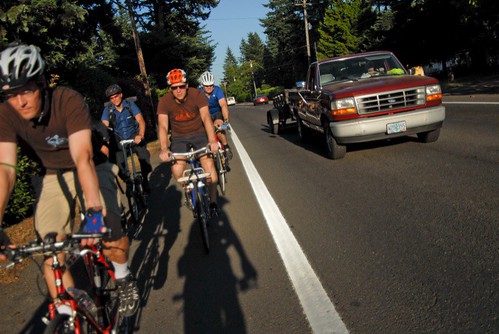
(Photo: J. Maus/BikePortland)
While ODOT marches forward, representatives from EPAP aren’t satisfied. They want a meeting with Windsheimer to hear further clarifications about why ODOT is unwilling to extend the south-side cycle-track. They also want to know more about the underground water pipe concerns ODOT has on the north side of the street. “I do think we need some answers about the stormwater system,” EPAP’s representative Jim Chasse said Wednesday night, “And we think the south side of Powell would be a good place for a complete raised facility. If we don’t get it right here, it’s going to reflect on the rest of the corridor.”
—
Chasse’s comments were echoed by EPAP Co-chair Arlene Kimura. “If you’re going to ask for an [design] exception for four blocks, why not go the whole mile?”
And it’s worth noting that ODOT hasn’t promised the cycle track pilot will happen at all. It’s listed as “potential” in their presentations. Asked whether he felt the four-block cycle track pilot would actually become a reality, Chasse didn’t mince words. “No, I think that was thrown in as bait,” he said. Chasse has every reason to be cynical. ODOT dangled the potential of physically separated bike lanes on outer Powell in front of advocates in 2012 — only to build conventional five-foot bike lanes in the end.
The City of Portland’s Bicycle Advisory Committee isn’t satisfied either. In a November 16th letter (PDF) — which was co-signed by the City’s Pedestrian Advisory Committee — they said, “After careful review of the proposed update to the Transportation System Plan and the Bicycle Plan for 2030, as well as discussions with PBOT staff, we feel that the current proposed buffered or tuff curb design does not meet the City’s goal to design facilities that will attract all ages and abilities, nor does it utilize best practice design that is suitable for main arterials in Portland.”
For their part, ODOT isn’t closing the door to debate completely yet. Horning says they’ll still be open to discussions about minor design details, but she feels the agency is set to move forward. “There will be more opportunities for discussion,” she wrote in an email yesterday. “I think we are headed in a really good direction and that this project is going to be a game changer for this section of Powell Blvd. I’m very excited to be moving forward with design of ODOT’s first separated bikeway.”
The project is slated to begin construction at the end of 2018 and be completed in 2019. You can contact ODOT with your thoughts about this project at OuterPowellSafety.org
— Jonathan Maus: (503) 706-8804, @jonathan_maus on Twitter and jonathan@bikeportland.org
BikePortland is supported by the community (that means you!). Please become a subscriber or make a donation today.


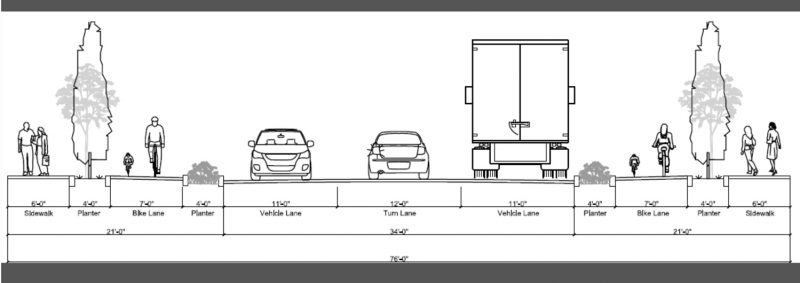
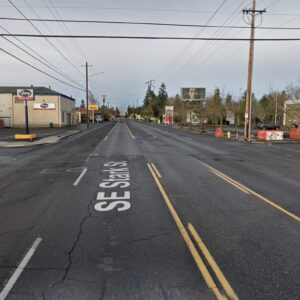



Thanks for reading.
BikePortland has served this community with independent community journalism since 2005. We rely on subscriptions from readers like you to survive. Your financial support is vital in keeping this valuable resource alive and well.
Please subscribe today to strengthen and expand our work.
Per the raised delineators with wands: Has the issue of maintenance (aka street sweeping) been thoroughly investigated? Perhaps this combo will only be placed in high conflict areas (intersection approaches)?
And in other areas the wands would be left off…like in Europe?
As of right now, the wands will be used along the entire corridor…. But of course there will be many many breaks in the chain because of all the driveways.
man. looking at the satellite map of the area, its really too bad that someone allowed development without SE Bush (or any other nearby East/West street) being a continuous street through. I mean it could have been a great bike boulevard and much more comfortable than riding along a busy street like Powell. With high traffic volumes and 30MPH+ streets, a normal bike lane isn’t enough, so I’m glad to see that some attempts to make Powell a nicer ride.
The party in charge was Multnomah County, decades ago.
Back in them thar days, it was considered “best practices” to have non-connecting streets in residential areas, so as to force traffic onto the arterial grid of superblocks. Multnomah County did try to install 10 foot walking paths here and there to connect children to schools, but that project was nixed when Portland annexed the area between 1986 and 1991. The city has had over 25-30 years to fix everything, which of course they only made it worse by encouraging high-density development where few basic services existed and allowed developers to not build sidewalks (waivers of remonstrance).
And even today, I hear tell of those who would make the local street network harder to navigate in order to reduce traffic impacts from newfangled roads like Powell and Division.
Except that in this case, Powell predates nearly all streets in East Portland (and much of the city for that matter) except Sandy (both were Indian tracks), and even Division is pretty old (a section-line road that not only divided farm land, but was itself a surveyor’s division mark.) It’s the residential streets that are newfangled, tho’ some are newer than others.
I’m harkening back to the era of mastadon paths and sabertooth tiger tracks. Newfangled indeed.
Regarding the “100 year-old water pipe”, could the raised bike lane be built instead using a lift of asphalt with a precast and pinned curb vs. excavating for cast in place concrete work? (The former is not as solid but it should last until the water line needs to be replaced – just a guess.)
ODoT + PBoT: how about doing a demonstration with using a RUP(reusable urban pavement), these are prefab concrete dowelled panels that can be quickly installed and removed for utility access…plus the demonstration could develop a thinner panel for just the raised bikeway sections (not the driveway or intersections), if the standard thickness would impact the heritage utility line. [See the article: Utility Player, Roads & Bridges magazine, January 2017, pages 18-23]
https://www.roadsbridges.com/utility-player
http://www.cptechcenter.org/ncc/TTCC-NCC-documents/Sp2013_TTCC/Tues08%20Moellman%20Fort%20Miller.pdf
What I find fascinating about these water pipes is that the city used to be very secretive about where exactly the pipes are located, presumably for security reasons, as portland’s entire fresh water supply runs along them. I’m not sure of the pipe under Caruthers, but from the Division BRT project, we now know the water pipe is more or less down the center of Division (LRT/streetcar tracks are apparently not an option), while the pipe seems to be on the north side of Powell, just north of the present-day bike lane.
Given the volumes of fresh, pure water involved, that secrecy is kind of pointless — any idiot with a dousing rod should be able to find those pipes in a matter of minutes. Unless, that is, they are run down first by a some yokel reading the president’s latest twoot as he merrily rolls along.
Remember what happened with 17th… PBOT/ODOT built something that already felt like a major lost opportunity on opening day (for almost zero cost, we could have had a separated bike facility, but instead we got on-street lanes). PBOT chalked it up to “that was the standard when we designed this thing.” I don’t want that to happen on Powell.
I think that PBOT and the community need to push for the most advanced design we can come up with; things are changing rapidly, and it is almost a certainty that by the time this actually gets built, the state-of-the-art will have advanced, and whatever we build will feel outdated.
I say to ODOT: Be bold; lean forward; show us your best work.
Ooops… that should have been PBOT/Trimet. That one’s not on ODOT.
Perfection is nice when you can afford it, but remember why we are doing this project in the first place – it’s to get sidewalks along a roadway that has always lacked them. The longer the project delay, the longer local residents will continue to be without sidewalks.
The delay is due to ODOT stonewalling and lack of care and flexibility; it can’t be reasonably blamed on activists.
AKA, south waterfront?
Contact them and raise hell.
http://www.outerpowellsafety.org/contact.php
Done (tactfully and considerately)! Thank you for providing the link. Can we get the link to this form included at the end of the news article itself?
I wish Bike Portland would start linking those kind of contacts but they typically don’t. You have tons of viewers why not create an action step when the opportunity presents?
There are several areas of concern here, but I will mention one that comes to mind immediately: If the proposed intersection is meant to prevent right hooks with bike signal displays, why not make the right turn lanes have bike boxes before the intersection? It is one additional element that can help bring attention to the traditional “No Turn On Red” signage that usually accompanies bike signal displays. The activated and illuminated signs that display “No Turn On Red” but even in those situations, people are often tempted to complete right turns on reds perhaps because it’s “so close and quick”. The physical separation of the bike box turns the maneuver into a deliberate decision rather than what I believe to be the unconscious training and conditioning that comes from engaging in right turns on red. Yes, it is an ODOT highway but the intersection falls within the City of Portland where bike boxes are canon.
Interestingly, the green bike boxes are very rare in East Portland. I’d love to hear from PBOT why that is.
I’d like to hear more about ODOT’s concerns about the incompatibility of a raised separated bike lane with driveways, side streets, and service vehicles. I consider these details to be important considerations for design related decisions, but not reasons to reject the whole class of raised bike lane facility types. I actually have a difficult time imagining how well the vertical posts would work better with the frequent breaks in the separation for driveways.
In fact, maintaining raised elevation of separated bike lanes is one of the best design practices for improving safety of bicyclists using the bike lane. At crossings, street level separated bike lanes have increased crash risk for bicyclists over raised separated bike lanes. ODOT should know this.
The 2016 SF Raised Bike Lane report* (one of the first US studies on raised bike lanes) is very clear in their findings. Raised bike lanes with a “vertical curb offers the most separation/deterrent to vehicles entering the bikeway.” (p.12)
The vertical curb is important. A rolled or mountable curb (which I believe was previously under consideration by ODOT) did not perform as well, the study found that the mountable design was perceived as “inviting,” offers poor separation from vehicles, and is a poor deterrence from illegally parked vehicles.”
*SFMTA. Market Street Raised Bikeway Demonstration Project: Findings Report. 2016.
When I interviewed ODOT and advisory-committee folks about this last summer, it seemed as if a major argument that had been mounted against a raised bike lane on the south side was that it would have to go up and down for all the driveways so it would be “like riding a roller coaster.” I asked the ODOT folks why, in sections where sidewalks are being built anyway, the driveways couldn’t be built with a sharper slope, so the bike lane could remain flat from the bike user’s perspective and people driving would get more of a speed-bump effect when they turned off Powell to cross bike lane and sidewalk. Never got a solid answer to that.
Nick, is this the study you’re referencing?
https://www.sfmta.com/sites/default/files/projects/2016/Market%20St_Raised%20Bikeway_Evaluation.pdf
Yes, that’s the study. While some interpretations of the results conclude that the mountable curb is preferred over the vertical curb, I think that only applies in reduced width dimensions where bicyclists don’t have room to ride side by side. In ODOT’s 8 ft scenario, the vertical curb would work well.
I agree with you on the driveways. Here’s a great Mark Wagenbuur video showing a level raised separated bike lane through driveways: https://www.youtube.com/watch?v=6imqI8VfwNo
There is also the pedestrian issue – the higher the barrier, the harder it is for a pedestrian to “jaywalk” or to catch the bus. If Powell was a normal city street in inner portland, then there would be a signalized crossing every 600 feet or so. But since this is East Portland, there are much fewer signalized crossings, so local pedestrians must jaywalk regularly to get anywhere, including to local schools, shopping, catch the #9 and 17 buses, etc. And there a lot of pedestrians along this stretch, with many immigrants and people of color. The mountable curb that ODOT proposes is easy to step over, walk on top of, and see at night, and harder to trip over.
Do immigrants and people of color have a special difficulty with curbs?
They do when they are trying to catch a bus along Powell, and they have to step off the sidewalk, then over a bike facility being used by fast people in spandex.
That would seem to affect other populations more… say those with mobility issues, rather than specific races or immigration statuses. Unless, of course, you are factoring in pursuit by our new federal stormtroopers.
Compared to the rest of portland, this section of East Portland along Powell has one of the highest levels of poverty, crowded apartments (high density by population but not necessarily by household), racial and ethnic diversity, children, and immigrants, including (white) Russians, (tan) Iraqis, (black) Somalis, etc, as well as native whites, people with various challenges (physical as well as behavioral). Immigrants in general walk more than native-born white residents, according to the US census and many other sources. Anyone who has been to this locale (and I have been there many times) can see many pedestrians along this roadway, and they are ethnically more heterogeneous than anywhere in inner portland, including women pushing strollers with kids on the roadway, since there are still no sidewalks to speak of. And as long as this project continues to be delayed, there will continue to be no sidewalks.
Anyone can see that outer Powell has a problem. Lots of people walk there, all parties agree there is a pressing safety issue along the corridor, and there is an active, funded project to improve at least one stretch of the road. What bearing does the skin color or immigrant status of the people walking there have on the situation?
Race and immigration status absolutely matter when you are talking about addressing equity issues. Areas with high numbers of minority communities have historically been ignored by the city. How are we supposed to address underserved communities if we don’t understand who we are trying to serve? To frame this as simply a mobility issue is absolutely naïve – transportation is intrinsically linked to socioeconomic issues.
We’re not talking about addressing equity issues. We’re talking about how to create the best bike/pedestrian facilities we can along Powell. The answer is the same regardless of who lives there.
For best practice, I should think the driveway access would go up over mountable curbs instead of having the cycle path going up and and down. Use vertical curbs where there are no driveways and mountable curbs in places where cars need access. In this way the drivers are forced to navigate slowly across the cycle path.
exactly! Treat teh raised bike lane like a sidewalk- the driveway goes up and over. This keeps the travel smooth for the bikes and helps slow down people entering the driveways.
Even raised bike lanes, like those you find in Denmark, seem like asking for second best to me. Copenhagen has a high mode share but the Netherlands is the real world leader in bicycle infrastructure. Check out this site:
http://www.aviewfromthecyclepath.com/2010/07/not-really-so-great-cycle-path-design.html
Here’s a quote:
“I [David Hembrow] think it’s about time that infrastructure like this stopped being touted as advanced. It is quite similar to what the Dutch used to do twenty years ago, but most of that has been replaced.
If you’re looking for a cycling “role model”, The Netherlands is the country which has achieved most and it is the country that you should refer to for best practice.”
ODOT’s design puts through (bike) traffic to the right of a right-turn lane, creating an inherent conflict. Not cool, ODOT.
Absolutely!
Tired of all the pretty drawings and the PR flim-flam.
Enough with the feel-good ticky-tocky.
Technically speaking its: “feel-good check boxy” 😉
The state speed control board is only involved in speed order changes if the requesting jurisdiction disagrees with ODOT’s decision.
“new traffic signal ODOT will install at the intersection with 122nd”
why are they installing a bike lane we’re not legally required to use due to it being to the right of a turn lane?
and how is this going to prevent right-hooks? a “no turn on red” sign that drivers won’t notice or obey?
the way to prevent right-hooks is to not put bikes to the right of turning traffic… it’s really that easy, especially at a huge intersection like this with lots of room…
Yes!
I agree that no right turn on red compliance is a concern. That said, the bike lane to the right of right turn lanes + bike signal combination works well at NE Broadway & Williams, so it can probably work here.
Is the signal ever green for both bikes moving forward and right-turning cars?
no, separate phases…
That means that cyclists will have a red light for the vast majority of the signal cycle.
Well, that depends on the details. Do you think the signal at NE Broadway & Williams is set up with excessive delay? This would be a similar condition. The phasing diagram shows that bicyclists moving forward would travel at the same time as motor vehicles moving forward.
Ah, ok, I misunderstood. Cyclists can go forward at the same time that cars can, and only “lose” the time when cars are moving forward & turning right while the cyclists are not moving.
I saw a (probably) oblivious driver turn right at Clinton & 8th this morning, against the illuminated “No Right Turn” sign, so share some of the skepticism expressed by others that drivers will obey a signal that runs counter to a well established expectation of how things will work.
Personally, I have found compliance with the illuminated “No Turn” light abysmal at the intersection of NE Rosa Parks (formerly Portland Blvd) and the Interstate 5 on-ramp. My skepticism is high if ODOT believes that a sign alone will be enough to prevent right turn hooks at the intersection with SE 122nd Ave and Powell Blvd. Yes, I have contacted them regarding this issue with suggestions on how to increase compliance with the intended signage.
I regularly see car drivers not taking notice of “No turn right” signs, simply because they do not expect suchc a sign. If I point it out they seem genuinly surprised and confused that the sign exists. In Europe the default is not to be able to turn right and drivers act with that expectation.
Compliance of the “no turn on red” at Couch and Grand is abysmal!
Wow…when I first saw the lead photo I thought I was looking at “old” E Street in Washougal…what with the lack of sidewalks, curbing and tumbledown commercial buildings…but I guess Oregon (and ODOT) has its share too of deficient commercial corridors/ arterial highways.
Plastic curbs and plastic wands are a reasonable alternative when you are trying to buffer a short stretch of bike lane. For example, they work well on the short bit of the Hawthorne bridge. For a major roadway project like this, which covers 14 blocks and is hopefully intended to be permanent, plastic curbs/wands are a poor idea. They are unsightly and will be a maintenance burden as they deteriorate and are damaged.
A buffer using sections of actual concrete curb, with vertical sides and 4″ or 6″ high, spaced to allow rainwater drainage and driveway access, with reflective markers, would work better, look better, last longer, not cost much more, and would not interfere with eventual replacement of the pipe. Drivers will not willingly drive over such curbs at speed, as the impact and damage to the tires, wheels, and in some cases undercarriage would be a major deterrent.
A raised bike lane would be excellent, and there is no reason why it has to dip at driveways, but the drainage and pipe issues do seem real.
That said, PBOT’s failure to buffer most of its own bike lanes with anything other than paint, and sometimes plastic wands, surely diminishes its credibility with ODOT.
Just look at the diagram for the 122nd Ave intersection – the PBOT facilities on 122nd are pathetic! And on 136th they are non-existant.
Maybe I am misunderstanding, please correct me if I am, but is the choice to build an at-grade bike over an old pipe or a raised bike lane over an old pipe? Wouldn’t the raised lane lane simply provide more cover? and isn’t more cover more protection? What am I missing?
Looks like a MAP bike in one of the photos…Ian, perhaps we need a “slug bug” ritual…
I wonder if Adam H is okay. Usually he’s first to comment on these types of articles.
I’m taking his shift today.
It is hilarious that PBOT is so upset with ODOT about proposing sub-standard cycling facilities when PBOT is equally willing to install far worse infra on their own streets. Pot calling the kettle black, much?
Whenever PBOT is reconstructing roadways, the sure do push to implement these raised, separated designs. SE 17th is the exception, but SW Multinomah, NE Cully, SW Moody, SW Bond are all examples of new streets constructed with robust separated bikeways, all cutting edge at the time.
ODOT is doing major reconstruction of this road, and has the opportunity to really build something great at with a relatively low added cost. It would be a shame to end up with a retrofit-style bike lane on what is basically a reconstructed street.
Foster is getting a complete rebuild east of 82nd and is still only getting door-zone bike lanes.
Not a complete rebuild like Powell. Check your facts.
It is going to be a complete rebuild now. I emailed Rich Newlands at PBOT and he informed me thusly:
OK. Rebuild. How would you apportion the 60-foot right of way?
12′ Sidewalk | 8′ Cycleway | 10′ MV Lane | 10′ MV Lane | 8′ Cycleway | 12′ Sidewalk
Mu thought as look. Looks a lot like hypocrisis to me. There are plenty of examples where PBOT has not implemented the best infrastructure for bicyclists or pedestrians in the recent past. Williams / Vancouver — where are the fully separated bike lanes? PBOT could also reconfigure many streets with little money to calm and reduce traffuc in the city but do not.
“Windsheimer also denied the request to install HAWK signals instead of flashing beacons and medians, citing high motor vehicle user compliance with existing beacons on other ODOT highways.”
except for those couple times there was no compliance and people died…
My experience with flashing beacons is considerably poorer than ODOT imagines it to be. While I was not personally killed yet, there were plenty of times I would have been, had I trusted the signal. Although, I see HAWKs as only a marginal improvement.
If you do get personally killed, please post and describe your experience.
I’ll do my best. If my phone is crushed, no pictures, though.
Look at how many 100 year old water mains broke in the recent freeze/thaw cycles – that pipe has a very limited life expectancy. Replace the %$#@ thing as part of the project. Figure out a way to share that cost with BES.
building new stuff on top of really really really old stuff seems odd.
My understanding is that it is a major fresh-water pipe that used to run from the Bull Run water shed to Mt. Tabor, but now connecting the new covered reservoirs on Powell Butte to the distribution reservoirs at Kelly Butte and Washington Park. It was built over 100 years ago. There are similar pipes under Division and along the Caruthers corridor.
As far as “building new stuff over old stuff”, this happens downtown all the time.
Do they build over something this big, and serving as many users as this pipe probably does? The second half of that is a genuine question, because any given footprint downtown has a lot more bodies in it than anywhere else in the metro area. What area does this line serve?
Nickle to a hole in a doughnut that the as built will be 4 lanes, no bike path, and no trees, just a curb and a 4 foot sidewalk.
So, people walking get a sidewalk behind trees, but people biking get to be in the cheese shredder between cars and the trees at car level? Somehow, we all deal with sidewalks intersecting every driveway in most of America…but a raised bike lane-AKA, wide sidewalk, is a problem?
Biased much ODOT?
It seems pretty simple. Wide, wide sidewalk striped for people and bikes (even though MUP’s aren’t). Keep cars on the low road and bikes/people on the high road. See, just saved you 18 months.
Agreed. The bioswale buffer needs to be in between the driving lane and the cycling lane.
Thank you Jonathan for providing an excellent article for the biking community to see the process as it has evolved over the years.
I continue to see this project as an opportunity for ODOT to show local residents, the cycling community and the City of Portland that ODOT can build a biking facility that would encourage all types of users.
The preferred option from the community advisory committee was for raised bike lanes. Given that this section of Outer Powell goes through a commercial district, it also provides an opportunity for accessing the district via an enhanced bike facility. This would provide local businesses a way to capture additional revenue from active transportation users.
Jessica Horning expressed ODOT’s concerns that the $20 million budget for this project (14 blocks) has gone to an estimated $28 million because of the cost of acquiring additional right of way. Had the project been done 10 years ago the estimated cost would have been approximately $11 million. That was the number that former Region 1 manager Jason Tell put forth at a Land Use and Transportation Committee meeting in 2008.
The community wants this project to move forward, but still want the raised bike lane pilot project to cover the full length of the south side of Powell. It would give all involved an opportunity to really evaluate how a “World Class” bike facility would work given the constraints of the project.
My hope is that ODOT will be open for further discussions.
We’ll keep you posted.
Go big on Powell. Go protected. More street trees.
YES! They are going to be cutting so many of the huge Doug Firs that re iconic in East Portland! They should try to carve out at least one 10’x8′ tree well per block face for replacement Doug Firs!
Now this is long term planning. I like it!
Outstanding, comprehensive, super thorough reporting, Jonathan–thank you!!
Personally I think it’s a huge waste of resources. There are far more important places to put a buffered bike lanes that are used every day by many more people than outer Southeast Powell.
Few people ride out there and it’s not because it’s unsafe. I lived out that way at 181 and commuting daily into town. A bigger problem is that the west bound Powell bike lane ends at 99th leaving you high and dry with no where to go safely. And it’s near the skate park where people might actually ride bikes and boards to and from.
You know, it’s not a zero sum game. Cities require developers to out in sidewalks that might never connect or be used all that often…Yet…There they are. If new pavement is being out down, protected lanes (like sidewalks) should be put in. It doesn’t have to be a billion dollar thing. Look at the Netherlands, it’s 3 inches higher of asphalt. Don’t make this complicated.
I basically agree, but… this may be a one-time opportunity. If we don’t do it now we’ll probably never have better bike facilities on outer Powell. Would I choose to start here? No… but I don’t have a choice.
The fact that we now say “facility” and “world class” makes this a mountain out of a mole hill. It’s a road that serves two users. Just get it done.